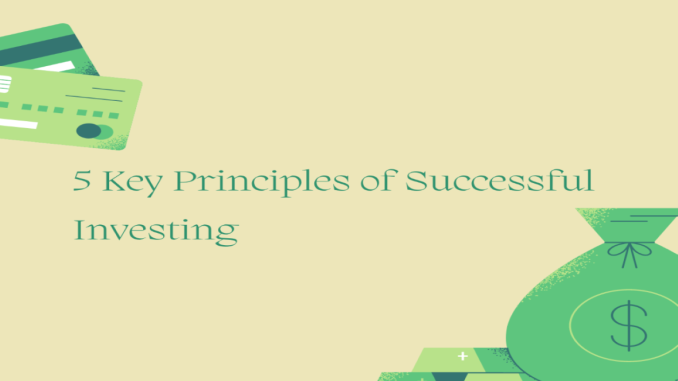
Investing in the financial markets can seem daunting, especially when you’re just starting out. However, long-term investing—when done correctly—can be one of the most rewarding financial strategies. Whether you’re building wealth for retirement, saving for a big purchase, or simply aiming for financial independence, long-term investing has the potential to grow your money steadily over time.
To help you succeed in this endeavor, here are five key principles that will guide you through the maze of investment options and ensure that your approach to long-term investing is both effective and sustainable.
1. Start Early and Be Consistent
The earlier you start investing, the better your chances of accumulating significant wealth over time. The concept of compounding is a powerful tool that works in your favor when you begin investing early. Even small amounts invested regularly can grow into a substantial sum, thanks to the compounding effect.
Consistency is equally important. Instead of waiting for the “perfect” time to invest, it’s better to commit to a consistent investment schedule. Whether it’s monthly or quarterly, automated investments help you stay on track and take advantage of market fluctuations.
Many successful long-term investors like Warren Buffett have emphasized the importance of starting early. Time, when paired with consistent contributions, will likely work wonders for your financial future.
2. Diversify Your Portfolio
One of the golden rules of investing is diversification. By spreading your investments across different asset classes—such as stocks, bonds, real estate, and even alternative assets like commodities or cryptocurrencies—you reduce the risk of putting all your eggs in one basket.
Diversification helps mitigate the impact of market volatility on your portfolio. When one investment suffers a downturn, others might perform better, balancing the overall risk. Over time, a well-diversified portfolio tends to grow more steadily and with less emotional stress than investing in a single asset class.
Consider a mix of domestic and international assets, as well as different sectors or industries, to ensure that you’re not overly exposed to any one type of risk. Tools like exchange-traded funds (ETFs) and mutual funds make diversification easier, even with a small amount of capital.
3. Focus on Quality, Not Timing
A common mistake among new investors is trying to time the market. Timing involves predicting when stock prices will rise or fall, and although it might work occasionally, it’s not a reliable long-term strategy. No one can predict short-term market movements consistently.
Instead of trying to time the market, focus on investing in quality companies or assets that have a proven track record of growth. Look for businesses with solid fundamentals, strong management, and sustainable competitive advantages. These companies have a better chance of weathering economic downturns and bouncing back stronger in the long run.
For example, many successful long-term investors focus on blue-chip stocks—large, established companies with a history of reliable performance. When you invest in quality, you give your portfolio the best chance to grow steadily over time.
4. Ignore Short-Term Market Noise
The financial markets can be highly volatile, with frequent news cycles, rumors, and short-term price swings. It’s easy to get swept up in the latest market panic or the promise of a “hot stock tip.” However, if you want to succeed in long-term investing, it’s crucial to ignore short-term noise and stay focused on your long-term goals.
Emotions like fear and greed can cloud your judgment and lead you to make impulsive decisions. Staying calm during market volatility allows you to make more rational, objective choices. Many of the most successful investors avoid trying to predict short-term movements, preferring instead to stay invested for the long haul.
Remember, market downturns are a natural part of the investment cycle. Rather than reacting to each fluctuation, it’s better to keep your eyes on the bigger picture and stick with your investment plan.
5. Reinvest Earnings for Maximum Growth
Reinvesting your earnings—whether through dividends, capital gains, or interest—can significantly enhance the growth of your portfolio over time. Rather than cashing out your returns, consider reinvesting them to buy more shares or assets.
This strategy allows you to take full advantage of compounding returns. For example, if you earn dividends from stocks or interest from bonds, reinvesting those earnings will give you the opportunity to earn returns on the dividends or interest themselves. Over time, this process can significantly increase your portfolio’s value.
Many mutual funds and ETFs offer automatic dividend reinvestment plans (DRIPs), which make it easy to implement this strategy. By reinvesting your earnings instead of cashing out, you ensure that your investment continues to work for you, compounding over the long term.